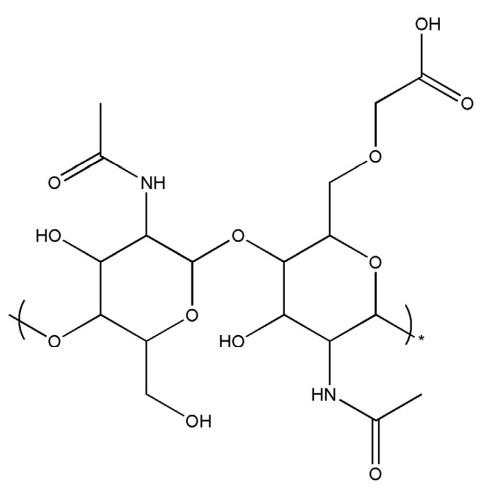Tokura et al. reported the method for obtaining carboxymethyl chitin (CM chitin, as shown in Fig.1) in 1983. In this process, the chitin was first prepared as alkali chitin by putting the chitin powder in 60% NaOH aqueous solution at 4℃ and -20℃ for 1 h and 1 night, respectively. Then the alkali chitin was used directly for CM chitin preparation. The obtained alkali chitin was dispersed in the isopropyl alcohol at room temperature, to which monochloroacetic acid was added until neutral. After separation, the residue was extracted with water. Acetone was added to the water extract to precipitate the CM chitin Na salt, which was treated with HCl (2N) to give the CM chitin with DS of 0.6. In the FT-IR spectrum, the additional peak at 1730 cm-1 attributed to carbonyl proved the carboxymethyl chitin was produced.

The CM chitin is already available on the market, and has been studied and applied widely. According to Kong et al. , the CM chitin showed an antiobesity effect by inhibiting adipogenesis and inducing lipolysis of 3T3-L1 cells through affecting the aquaporin-7 and adenosine monophosphate-activated protein kinase (AMPK) pathways.
Moreover, CM chitin can be used to make nanomaterial. According to Dev et al., CM chitin nanoparticles were prepared in a cross-linking process using FeCl3 and CaCl2; the obtained diameters were 200-250 nm. The CM chitin nanoparticle was nontoxic, and showed a good inhibitory effect on Staphylococcus aureus. What’s more, the cancer drug 5-Fluorouracil (5-F)-loaded CM chitin nanoparticle can be prepared by emulsion cross-linking with FeCl3 and CaCl2 as cross-linking agent. The in vitro studies showed that the loaded CM chitin nanoparticle can release 5-F sustainably.
The CM chitin also can be used in other composite material. Shalumon et al. synthesized a CM chitin/poly(vinyl alcohol) (PVA) nanofibrous scaffold by electrospinning. In this method, 7% CM chitin aqueous solution was mixed with PVA aqueous solution (8%) in different mass ratios to produce nanofiber scaffold using electrospinning. Then the water-soluble scaffold was cross-linked with glutaraldehyde into water-insoluble products. The material has potential for tissue engineering applications, because calcium phosphate can be formed on the surface and human mesenchymal stem cells can be attached on and in it.